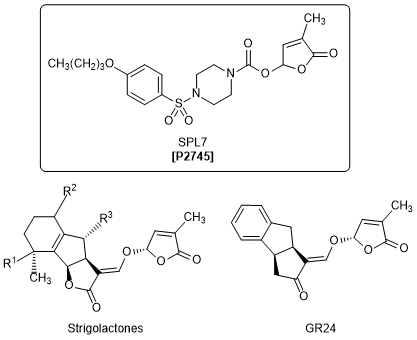Maximum quantity allowed is 999
Please select the quantity
Sphynolactone-7: Phytohormone Mimic Leading to Withering of the “Witchweed” Striga
Striga is a parasitic plant called “witchweed”, which has been significantly reducing the amount of grains yield especially in Africa.1) Striga germinates by detecting strigolactone, a plant hormone produced from a host plant. Sphynolactone-7 (SPL7) is a strigolactone mimic which can force Striga to germinate and wither in soil without the host plant as a nutrient source.2) The activity of SPL7 against Striga germination is extremely high compared with other existing strigolactone analogs like GR24,3) but SPL7 binds specifically to the strigolactone receptor of Striga. Furthermore, SPL7’s bioactivity as other plants’ hormone is very weak. So it is expected to be used as a revolutionary control method against Striga.

Related Products
References
- 1) THE STRIGA SCOURGE IN AFRICA: A GROWING PANDEMIC
- 2) A femtomolar-range suicide germination stimulant for the parasitic plant Striga hermonthica
- 3) Improved synthesis of strigol analog GR24 and evaluation of the biological activity of its diastereomers

